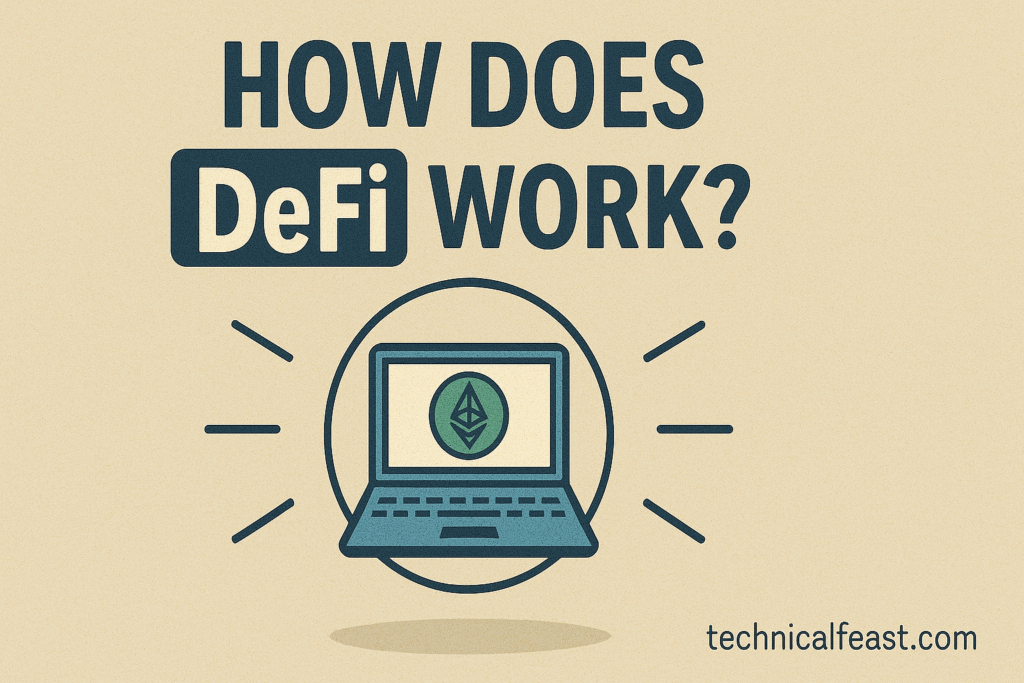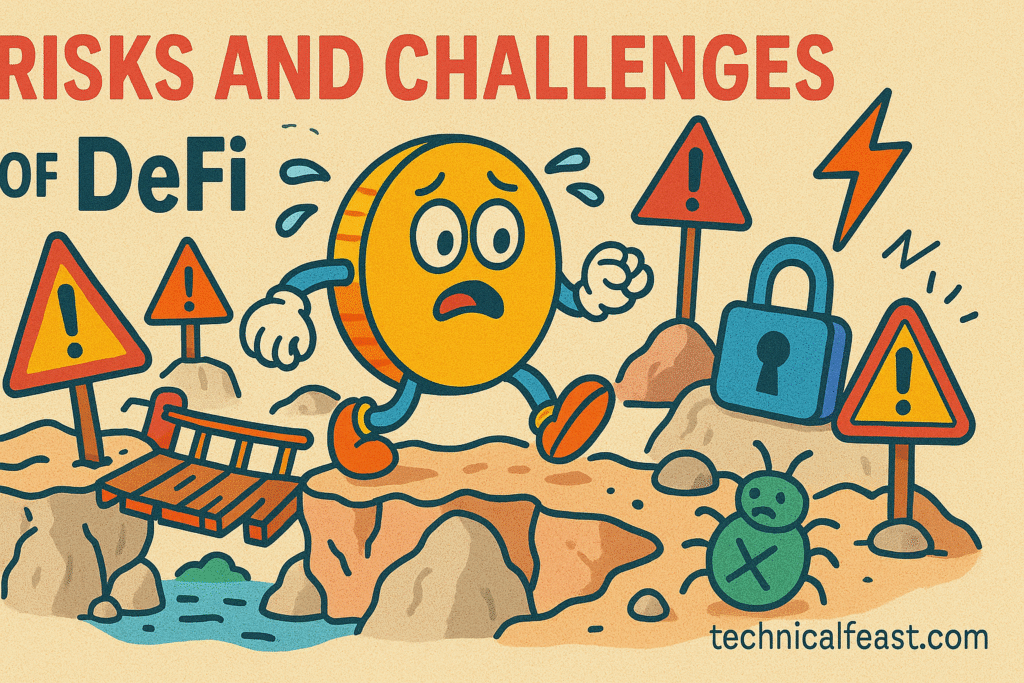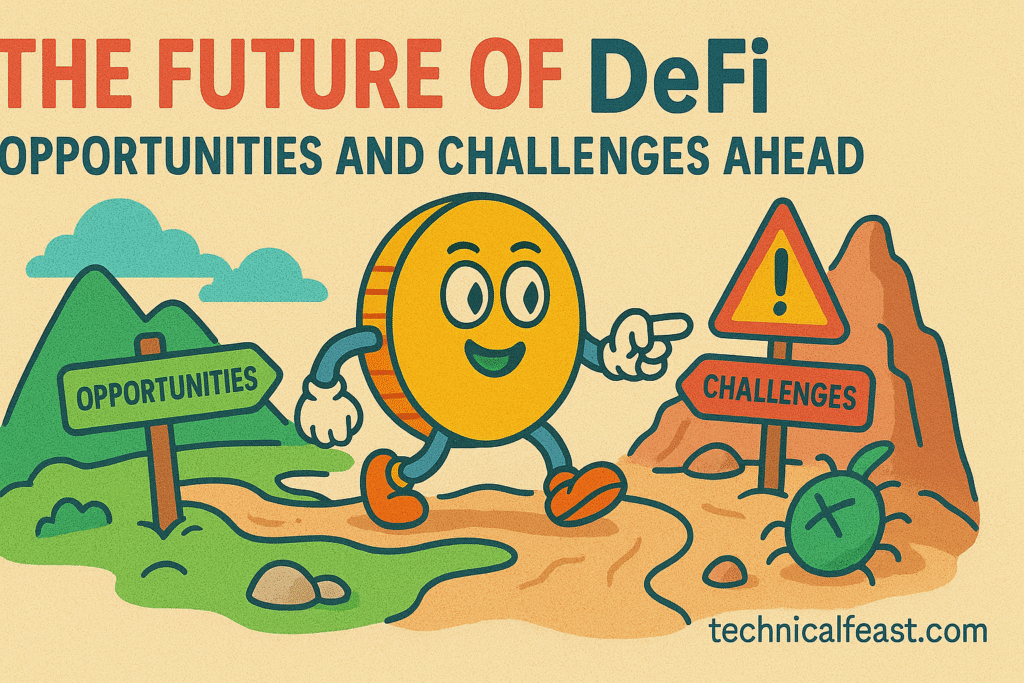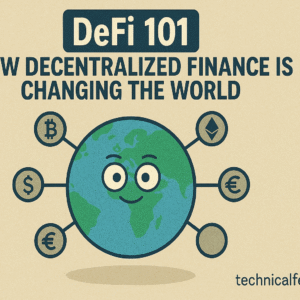Table of Contents
The world of finance is undergoing a dramatic transformation, thanks to the rise of Decentralized Finance (DeFi). At its core, DeFi aims to create an open financial system without the need for traditional banks or intermediaries. But how does this shift affect us, and why is it generating so much buzz? This guide will explore the fundamentals of DeFi, how it works, its impact on global economies, and the exciting future it holds.
What is DeFi? An Introduction to Decentralized Finance
DeFi stands for Decentralized Finance, a term used to describe a new wave of financial services built on blockchain technology. In traditional finance, transactions and services are controlled by intermediaries such as banks, brokers, and insurance companies. DeFi flips this model on its head by allowing individuals to access financial services directly, without relying on any central authority.
By using blockchain platforms like Ethereum, DeFi enables peer-to-peer transactions, lending, borrowing, trading, and more, all executed by smart contracts rather than traditional financial institutions. This decentralized approach promises to bring more efficiency, transparency, and financial inclusion to people across the globe.
How Does DeFi Work?
DeFi operates through a combination of blockchain technology, smart contracts, and decentralized applications (dApps). Here’s a closer look at how each component works:

- Blockchain Technology: The backbone of DeFi, blockchains like Ethereum allow decentralized and secure transactions without the need for a third party. Every transaction is recorded on a public ledger, making it transparent and immutable.
- Smart Contracts: These are self-executing contracts where the terms of agreement are directly written into code. Smart contracts automatically execute, enforce, and verify agreements without human intervention, making transactions faster and more secure.
- Decentralized Applications (dApps): These are platforms built on blockchain networks that enable users to interact with DeFi protocols. dApps can be used for lending, borrowing, staking, and more.
By leveraging these technologies, DeFi has created an ecosystem where financial transactions can happen more efficiently, cheaply, and transparently.
Key Components of DeFi: Lending, Borrowing, and Yield Farming
DeFi offers a wide range of financial services. Here are some of the most important ones:
- Lending and Borrowing
In the traditional financial system, banks act as intermediaries between borrowers and lenders. In DeFi, platforms like Compound and Aave enable users to lend their assets and earn interest or borrow assets against collateral without involving banks. This peer-to-peer lending and borrowing system operates in a decentralized environment. Real-World Example:
Sarah, a crypto enthusiast, lends her Ethereum on a decentralized lending platform and earns interest. Meanwhile, John, who wants to borrow Ethereum to leverage his investments, can do so without needing a bank loan. - Decentralized Exchanges (DEXs)
Centralized exchanges like Binance and Coinbase dominate the traditional crypto trading scene. In contrast, Decentralized Exchanges (DEXs) like Uniswap and SushiSwap allow users to trade directly from their wallets without an intermediary. These platforms enable peer-to-peer trading, increasing liquidity and reducing fees. - Yield Farming
Yield farming allows users to earn rewards by providing liquidity to DeFi protocols. Users can stake their assets in liquidity pools to earn interest or token rewards. This practice has gained popularity, with platforms offering high-yield opportunities in exchange for liquidity. Case Study:
In 2020, the rise of yield farming created a frenzy in the DeFi space, with platforms offering annual percentage yields (APYs) that surpassed 100%—a far cry from traditional savings accounts. This attracted new users to the ecosystem, looking to maximize their returns on crypto assets.
Advantages of DeFi: Transparency, Accessibility, and Financial Inclusion
DeFi offers several advantages over traditional financial systems, making it an attractive alternative for many users:
- Transparency: Every transaction on a blockchain is publicly recorded, making the system transparent and auditable. This allows anyone to verify the integrity of transactions, creating trust in the system.
- Accessibility: DeFi platforms are open to anyone with an internet connection. Unlike traditional banking systems, which can be inaccessible to people in certain regions, DeFi offers financial services to a global audience.
- Lower Fees and Faster Transactions: Without intermediaries, DeFi transactions are often cheaper and faster. This is especially true for cross-border transactions, where traditional banking fees and delays can be significant.
- No Centralized Control: DeFi eliminates the need for centralized authorities, such as banks, which means there’s no single point of failure. This decentralization also empowers individuals, giving them full control over their assets.
Risks and Challenges of DeFi

While DeFi offers tremendous benefits, it is not without its risks. Here are a few challenges users should be aware of:
- Smart Contract Vulnerabilities: Although smart contracts are designed to be secure, they can contain bugs or vulnerabilities that hackers can exploit. There have been incidents where bugs in smart contracts led to significant losses.
- Regulatory Uncertainty: DeFi operates in a largely unregulated space, and governments around the world are still figuring out how to approach it. Regulatory changes could impact the future of DeFi platforms and their users.
- Scalability Issues: DeFi platforms, especially those built on Ethereum, face scalability challenges. High traffic on the Ethereum network can result in slow transaction times and higher fees, which may limit the usability of DeFi platforms.
- Impermanent Loss in Yield Farming: While yield farming offers high returns, it comes with the risk of impermanent loss. This occurs when the price of one asset in a liquidity pool changes significantly, resulting in a loss for liquidity providers.
DeFi’s Impact on the Traditional Financial System
DeFi is challenging the traditional financial system in several ways. Here are a few key impacts:
- Disrupting Banks: By offering lending, borrowing, and trading services directly to individuals, DeFi removes the need for banks as intermediaries. This has the potential to reduce the power of traditional banks in the global financial system.
- Redefining Credit Scoring: Traditional lending systems rely on credit scores to determine the creditworthiness of borrowers. DeFi platforms, however, use alternative methods, such as over-collateralization, to assess risk, enabling individuals with no traditional credit history to access loans.
- Financial Inclusion: One of the biggest advantages of DeFi is its ability to provide financial services to the unbanked population. In countries with limited access to traditional banking services, DeFi offers an alternative that is more inclusive and accessible.
The Future of DeFi: Opportunities and Challenges Ahead

The future of DeFi looks promising, with continuous innovation and new use cases emerging regularly. However, several challenges remain:
- Interoperability: As more DeFi platforms emerge, the need for interoperability between different blockchains and networks will become crucial. Without seamless integration, the DeFi ecosystem could become fragmented.
- Regulation: Governments and financial institutions will need to find ways to regulate DeFi without stifling innovation. Clear guidelines will be necessary to protect users and ensure that the DeFi space grows sustainably.
Real-World Expert Opinion:
“DeFi has the potential to reshape the entire financial industry,” says John Doe, a blockchain expert. “However, it’s important to address the risks and challenges associated with it, especially when it comes to security and regulation. If these can be mitigated, DeFi will revolutionize the way we think about finance.”
Frequently Asked Questions (FAQs)
1. What is the difference between DeFi and traditional finance?
DeFi operates without intermediaries like banks, using blockchain technology and smart contracts. Traditional finance relies on centralized institutions for services such as lending, borrowing, and trading.
2. How can I get started with DeFi?
To get started with DeFi, you need a cryptocurrency wallet (such as MetaMask), some crypto assets, and access to DeFi platforms. Once set up, you can explore decentralized exchanges, lending platforms, and yield farming opportunities.
3. Is DeFi safe to use?
While DeFi offers many benefits, it also carries risks, such as smart contract vulnerabilities and regulatory uncertainty. It’s important to research the platforms you use and implement best security practices.
4. Can DeFi replace banks?
DeFi has the potential to challenge traditional banking systems by offering financial services directly to individuals. However, full replacement of banks is unlikely in the short term, as banks provide services that DeFi platforms currently can’t fully replicate.
Conclusion: DeFi is Here to Stay
Decentralized finance is changing the financial landscape, offering individuals more control, transparency, and accessibility. While there are risks involved, the potential rewards are immense. Whether you’re a seasoned crypto investor or just getting started, DeFi presents exciting opportunities for the future of finance. By continuing to innovate and solve the challenges that exist, DeFi could one day be the norm, disrupting traditional financial systems for good.




Leave a Reply